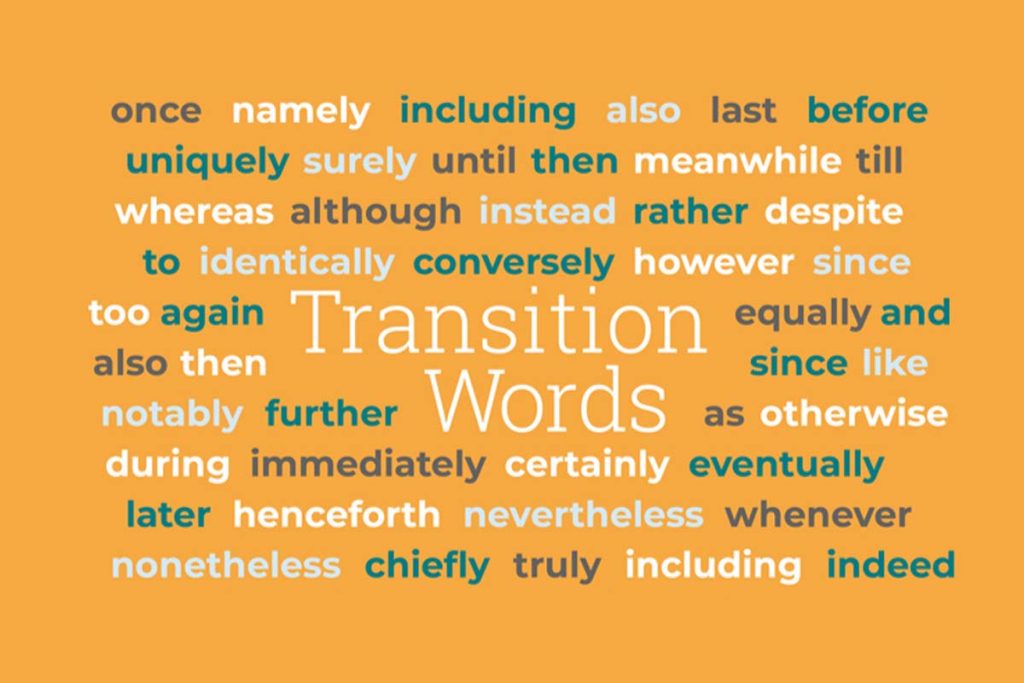Students employ a variety of writing genres, such as paragraphs, essays, research papers, thesis, and dissertations, to show how ideas flow logically into one another. And in English writing, just listing concepts one after another without adding transitional words is insufficient. In order for the reader to follow our mental process, we must illustrate the logical relationship between the concepts. To do this, we must explain how our sentences and thoughts flow together. With that in mind, if you are wondering how to add transition words in your essays, here is the best guide to help you learn how to use transition words in an essay.
What are the Basic Steps of Writing an Essay – Beginners Guide
What are Transition Words?
Before we start learning how to use transition words in an essay, let’s begin with the fundamentals. So, let us first understand what are transition words, anyway.
To connect sentences, we generally use transitional words and phrases. Similar to conjunctions, they form links and improve the flow of your writing. Why would you write in fragmented sentences when you don’t speak to people like that?
A comma is nearly often used after a transition word. If the two sentences are both complete sentences, you may also combine them with a semicolon rather than a period. This strengthens the link between your ideas a little bit.
Here are a couple of illustrations:
“She pushed the chair. As a result, he fell down.”
In the above illustration, the phrase “as a result” is a transition word. As your reader reads the above sentence, he understands two things.
- What happened in the first sentence that caused something?
- While the second sentence describes the effect.
“Sara missed the science quiz since she didn’t attend school on Wednesday.”
In the above example, the word “since” is a transition word that connects both sentences just like a conjunction.
You should use transitional phrases at the start of each paragraph in your body while writing essays. This not only facilitates your transition to your following idea but also sets up your subsequent point.
Why Should You Use Transition Words?
Even while it first looks like your sentences would be alright without transition words, they actually make a significant impact on the quality of your writing.
Sentences flow more smoothly when transitional words and phrases are used, creating a sense of continuity between two ideas or concepts. This helps your reader read essays more quickly and cohesively.
Take a look at the following example:
“Aliya did not do any homework throughout the entire semester. Her history class was unsuccessful.“
Here is the same sentence but now contains a transition word:
“Over the course of the semester, Aliya did not do any assignments. She thus dropped out of history.”
As you can see, by inserting a transition word between the two phrases, the concept that one thing led to another is connected and the sentences flow together.
Use transitional phrases in your essays to improve the flow of your writing and make connecting ideas between ideas simpler. This is particularly crucial at the conclusion of your body paragraphs when you need to flow naturally from one idea to the next.
Consider your sentences as a pile of bricks. You merely have a pile of bricks without the mortar to hold them together. However, using mortar gives you a way to hold those bricks together to create a building or a house that is sturdy. Similar to the mortar, the transition words play the same role.
Your sentences may be strong enough to stand alone, but using transition words helps the writing as a whole to flow more smoothly.
How to Use Transition Words in an Essay
Writing an essay is a really easy procedure. Start with coming up with a fantastic idea, then come up with some details and arguments for it. However, the main struggle is to know how to connect these details and arguments correctly.
After all, you can not just keep adding arguments and expect to get a straight A in your essay.
Similarly, if you have ever engaged in a discussion with someone who frequently jumped around while talking, you might have it challenging to comprehend what they are saying. The good news is that transitional phrases stop your writing from doing similarly.
The words “first,” “second,” “then,” and “afterward” are excellent for structuring a sentence. Although, you may also use words like “nevertheless” or “however” to connect ideas. In informal writing, even basic words like “and” and “but” can connect phrases and paragraphs.
Therefore, if you want the ideas or arguments in your essay to flow smoothly, you need to start using transition words. With that being said, let us learn how to use transition words in an essay step by step.
Step 1: Know the purpose of transitions in writing

I like to start with this piece of advice because you need to understand the goal before you can understand the rules. Not only can transitional words and phrases help you convey your thoughts coherently, but they are also an essential component of the writing process that shouldn’t be overlooked.
Without knowing how to move smoothly from one concept or paragraph to another, whether you’re writing for an academic project or a fictional novel, your writing will at best be unclear.
And this is true regardless of how much time and effort you spent in advance studying or preparing.
The worst-case scenario is that improper transitions between ideas or stages will result in a disorganized, unclear mess in your writing that your reader will find hard to understand. Other than that, you might even get less or grades or worse a college admission denial letter.
Therefore, it is indeed important to understand the purpose of adding transition words in your writing.
Step 2: Understand that logic is essential, especially in academic writing

The second thing you should be aware of is that in order to construct a coherent narrative or argument, transition words—also referred to as conjunctive adverbs—are required in practically every genre of writing. There is just no way to get away from them.
However, the only kind of writing that might not require transitions are those that are considered to be poetry. As was already said, it’s crucial to use the right transitions, whether in a single word or a whole phrase, to strengthen your paper’s logic or advance your plot.
We use transition words and phrases in our everyday speech to shift the subject, tell a tale, or even recount what happened throughout the course of the day. In our everyday speech, transition words like “so,” “then,” and “finally” are only a few instances of often used transitions. Here’s an illustration:
Father: John, where have been all day? I have been worried.
John: Dad, you had to listen, it was not my mistake.
Father: Whos was it?
John: The bus was late then we caught in the traffic. There was an accident. For that reason, we turned around and took another route; but there was traffic too!
In the above example, “then”, “for that reason”, and “but” are the transition words. Without them, John would have been grounded.
Step 3: Realize that there are categories of Transition Words and learn them
There are countless transition words in English. Therefore, there are several categories of transition words. Each category has a different purpose. The difference between these categories is easy to understand. But students usually find it hard to know where to use which transition word.
Therefore, if you want to learn how to use transition words in your essay, you also need to know that there are several categories of transition words. And you have to learn them to be able to use them easily.
With that being said, the different types of transition words are given below.
- Agreement, similarity, or addition
- Order or sequence
- Opposition or contradiction
- Cause or effect
- Support, emphasis, or example
- Place or time
- Clarification, summary, or example
Step 4: Decide Where to Place Transitions

We can use transition words anywhere in a sentence, including the beginning of the sentence, the middle, or the end. While the key purpose of using transition words is to connect ideas.
So, once you learn the different categories of transition words, you have to learn where to add these transition words.
- Beginning of the sentence: For that reason, we turned around…
- In the middle of the sentence: Sara, however, was still in a lot of pain.
- At the end of the sentence: Her treatment was quite successful by comparison.
Similarly, transition words can be used in the paragraphs of an essay too.
Finally, it is necessary to investigate how poverty affects education. Many kids who live in poverty lack access to transportation and other resources that would enable them to attend their preferred schools. Furthermore, the services provided by the programs in their region are inadequate. Therefore, it stands to reason that these pupils do not have access to the same level of education and services that children from middle-class families do.
The same rule applies to essays. After all, essays are built by putting sentences and paragraphs together, logically.
Step 5: Consider the Relationship and choose the Right Transition Words
Now that you where you need to add a transition word, you need to understand the relationship between the sentences, ideas, or paragraphs that you need to build. Does your sentence or idea agrees with the previous one or does it oppose it?
Then, find the most suitable transition word that you want to add. While doing so, you should remember that the transition word should help in making the sentences flow smoothly. If it does not do so, you may have either chosen the wrong transition word or you have misplaced the transition word.
Most Common Transition Words that You Can Use in Your Essay

It’s common knowledge that transition words should be used between paragraphs, but knowing which ones to use and where to place them may be challenging. It’s also challenging to think of fresh alternatives without automatically resorting to the words “although,” “but,” or “and.”
Thankfully, we’re always available to provide you with the necessary tools and resources. We are experts at using transitional words and phrases to link sections of your essay together and to ensure that your writing leaves the proper impression.
With that being said, here is our pick of the most common transition words you can use in your essay.
The agreement, Similarity, or Addition
- Also
- In addition to
- Moreover
- Furthermore
- Therefore
- As a matter of fact
- Similarly
- Equally important
- comparatively
- correspondingly
- Not only… but also
- As well as
- Thus
- In the same fashion
- In the light of
- Equally
- Too
- Even More
- Indeed
- Another
Order or Sequence
- Firstly
- Secondly
- Thirdly
- Next
- Then
- Finally
- Later
- After
- Simultaneously
- Presently
- Formerly
- Once
- Since
- As soon as
- Shortly
- By the time
- Both… and
- Afterward
Opposition or Contradiction
- In spite of
- Despite
- On the one hand
- Even though
- Though
- Although
- However
- Nonetheless
- Notwithstanding
- On the other hand
- Nevertheless
- Although this may be true
- Be that as it may
- Admittedly
- Conversely
- That said
- But
- At the same time
- Regardless
Cause or Effect
- With this in mind
- As a result
- Owing to
- Hence
- Consequently
- In as much as
- In the event that
- Because
- Provided that
- Unless
- Seeing that
- Subsequently
- Due to
- At the end that
- In light of
- So
- Thus
- Therefore
- In order to
- While
Support, Emphasis, or Examples
- For example or instance
- As an example
- Specifically
- More importantly
- Equally important
- Also
- Namely
- Again
- To illustrate
- Of course
- To put it another way
- As an illustration
- So that
- Certainly
- Especially
- Besides
- Including
- To include
- In fact
Place or Time
- After
- Nearby
- At last
- Afterward
- Then
- Before
- Back then
- In the future
- Nowadays
- Sometimes
- This time
- Previously
- Soon
- Following
- While
- During
- Now
- There
- Here
- Today
- Subsequently
- Immediately after
Clarification, Example, or Summary
- To illustrate
- As an example
- For instance
- For example
- To demonstrate
- Again
- Namely
- Truly
- Particularly
- Especially
- Specifically
- Also
- Besides
- Including
- To include
- Certainly
- More importantly
- As an illustration
- Above all
- So that
You can read more about:
- How to Write a Profile Essay – Step by Step Guide
- Scholarship Essay Tips to Make Your Application Stand Out
- How to Write an Argumentative Essay in English
- 5 Tips on How to Avoid Grammar Mistakes in Your Essay
- How to Check Your Grammar Mistakes in an Essay – 8 Best Tools
- What are the Basic Steps of Writing an Essay – Beginners Guide
- How to Write an Essay Fast in Eglish – Step by Step Guide
- Teacher’s Day Essay for Students in English
- Everything You Need to Know Before Buying an Essay Online
- Common Essay Mistakes Students Commit – How to Avoid Them
- How to Write an Analytical Essay in English
- The 10 Best Essay Writing Services You Will Rely on – Reliable Essay Writing Services

